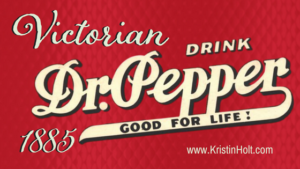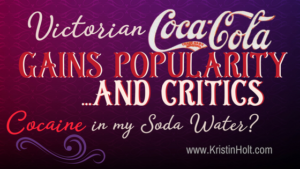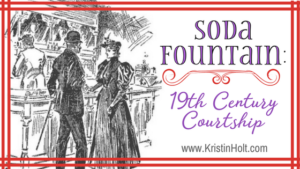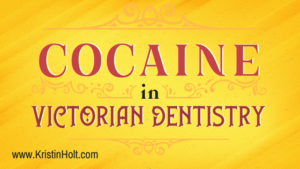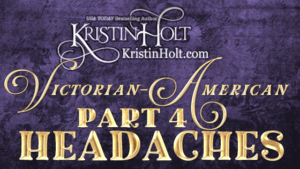Cocaine in Victorian Coca-Cola: Going… Going… Gone?
Cocaine in Victorian Coca-Cola: Going… Going… Gone?
.

.
REMEMBER: PATENT MEDICINE BEGINNING
.
When Coca-Cola debuted in 1886, it was sold in pharmacies (“druggist”), as a “brain tonic”, a remedy for indigestion and/or nervousness. And, among at least a dozen other benefits, as a “headache specific”. Coca-Cola may have tasted good (a spoonful of sugar helps the medicine go down)…but its origin is firmly planted in the Patent Medicine arena. Most medicines of the day contained substances such as cocaine, morphine, and/or alcohol. For Coca-Cola to have contained an appreciable amount of cocaine in its six-ounce serving size is no surprise whatsoever.
.
Yes, caffeine (from the Kola nut) can work wonders for some kinds of headaches. Yet Coca-Cola advertised numerous success stories of relieving ongoing, difficult headaches. As a severe headache sufferer, I’m not surprised that cocaine and caffeine would yield such a desirable result.
.
Sometime in the 1890s, the focus on health benefits, treatments of everything from dyspepsia to headache–and hence a Patent Medicine–slowly melted away. The already advertised “refreshing drink” tactic was going strong, and this became Coca-Cola’s focus in advertising. I draw this conclusion from the numerous vintage newspaper advertisements I’ve located while researching this blog article series… and from Snopes’s comment, (in full , below), stating that Candler and Robinson cut the amount of coca extract in their formula to a mere trace, at the time of the outcry in 1891 over the potential dangers of addiction to cocaine.
.
Perhaps the best look at the concept, in arrears, is from the title: Cocaine: From Medical Marvel to Modern Menace in the….
.
.

Cocaine: From Medical Marvel to Modern Menace in the United States, 1884-1920, p75. Image: Courtesy of Google.
.
Note that the first advertisement for Coca-Cola in National Druggist is cut off at the bottom of page 75 (and page 76 is not available inside the Google Preview, and understandably, the snippet above, attributed to the title [Cocaine: From Modern Medical Marvel to Modern Menace in the United States, 1884-1920] is a copyrighted preview.
.
But the following snippet is of the original source the author of Cocaine references: National Druggist, 1896, p. 214, providing the rest of the quotation in context.
.

“Coca-Cola a Triumph Over Nature.” This advertisement in National Druggist, 1896, p. 214 courtesy of HathiTrust.org.
.
![]()
.
TRUTH VS. MYTH
.
Even Snopes agrees. Coca-Cola once contained cocaine…but!…
.
… Just how much cocaine was originally in the formulation is hard to determine, but the drink undeniably contained some cocaine in its early days.
.
.
Citing Frederick Allen, who described the public attitude toward cocaine in the fountain beverage, apparently “as Coca-Cola’s developers worked on perfecting their formula in 1891.”
.
(Wait a minute… Coca-Cola had been available for six happy years by then. The product was selling like gangbusters, making a few men very rich. Popularity was growing! Why mess with something that’s selling! I submit that nothing was changing until the outcry over the medicinal ingredient (cocaine from coca leaves) hit the public’s awareness. After all, nobody squawked about what their other patent medicines included.)
.
However it unraveled, two things (apparently) happened in 1891:
.
1) Candler and Robinson (more about 1891’s media exposé in my last post) were anxious to continue promoting the supposed benefits of the coca leaf, but there was no reason to risk putting more than a tiny bit of coca extract in their syrup. They cut the amount to a mere trace. (emphasis added)
.
2) Cocaine continued to be an ingredient in the syrup in order to protect the trade name “Coca-Cola“. Candler believed that his product name had to be descriptive, and that he must have at least some by-product of the coca leaf in the syrup (along with some kola) to protect his right to the name Coca-Cola. Protecting the name was critical. Candler had no patent on the syrup itself. Anyone could make an imitation. But no one could put the label “Coca-Cola” on an imitation so long as Candler owned the name. The name was the thing of real value, and the registered trademark was its only safeguard. Coca leaves had to stay in the syrup.
.
.

.
ITTY-BITTY PINCH, OR A WHOLE LOT?
.
I’m not surprised to see a wide disparity between quoted sources (and original sources) for just how much cocaine was in “a glass”, as well as how many ounces were served in “a glass” (as that affects just how much cocaine any recipient consumed… nor have I seen any limits set by druggists. I can easily see someone consuming two or three glasses for a particularly tough case the patent medicine / soda fountain delicacy was touted to eradicate).
.
Asa Candler, as quoted in The Atlanta Constitution of Atlanta, Georgia, (June 21, 1891), [see link to this full article within Victorian Coca-Cola Gains Popularity… and Critics (Cocaine in my Soda Water?) post], gives a reference to how much coca leaves ends up in a glass… essentially useless information to anyone but a chemist (as the Snopes reference, above, illustrates with the following sentence:)
.
… He [Asa Candler] further said in his card that a gallon of coca-cola contained the extract of only a half ounce of coca leaves, and no sensible man would undertake to say that this quantity in a gallon would hurt a person taking a glass of the beverage.
.
Judd Hambrick (September 1, 2011, Southern Memories) is one who argues (without original sources to back up his statement) that original Coca-Cola contained more than “a trivial amount” of cocaine and caffeine:
.
[1903]… For the past 18 years since [Coca-Cola] was created in 1885, this renowned soft drink has contained some 9 milligrams of cocaine per 7 ounce glass and has a fairly large dose of the caffeine rich kola bean in every one of those servings, too. Those ingredients provide a powerful “pick-me-up” for thirsty customers everywhere.
.
~ Judd Hambrick, Southern Memories, September 1, 2011
(site accessed 7-8-17, 10:15 am)
.
Apparently Judd was correct.
.
Ricardo Cortés, Author and Illustrator, (in this YouTube Video, immediately below), stated, “Coca-Cola started getting rid of cocaine in about 1902. That’s a couple of years before cocaine was actually prohibited in 1914.”
.
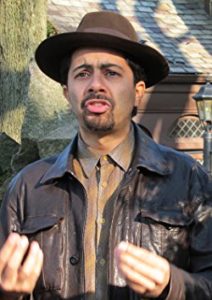
Ricardo Cortés, Author and Illustrator. Image: Courtesy of Amazon’s Ricoardo Cortés page.
.
Ricardo Cortés is the author and illustrator of the title:
.
A Secret History of Coffee, Coca & Cola “is an illustrated book disclosing new research in the coca leaf trade conducted by The Coca-Cola Company. 2011marked the 125th anniversary of its iconic beverage, and the fiftieth anniversary of the international drug control treaty that allows Coca-Cola exclusive access to the coca plant.
Most people are familiar with tales of cocaine being an early ingredient of “Coke” tonic; it’s an era the company makes every effort to bury. Yet coca leaf, the source of cocaine which has been banned in the U.S. since 1914, has been part of Coca-Cola’s secret formula for over one hundred years.
This is a history that spans from cocaine factories in Peru, to secret experiments at the University of Hawaii, to the personal files of U.S. Bureau of Narcotics Commissioner Harry Anslinger (infamous for his “Reefer Madness” campaign against marijuana, lesser known as a long-time collaborator of The Coca-Cola Company). A Secret History of Coffee, Coca & Cola tells how one of the biggest companies in the world bypasses an international ban on coca.”
.
(emphasis added) (Quote: courtesy of the book description on Amazon’s A Secret History of Coffee, Coca & Cola page.)
.
.
Now, to be fair, the whole point of processing the coca leaf to remove the cocaine (and seeing it safely into the hands of pharmaceutical company/ies) is to keep the flavor of the remaining leaf extract, without the “cocaine”–the alkaloid the scientists searched for and purportedly couldn’t find in the Coca-Cola syrups of 1904 and beyond.
.
.
.

.
AH! FINALLY–NUMBERS!
.
Coca – cocaine
.
Pemberton called for five ounces of coca leaf per gallon of syrup, a significant dose; in 1891, Candler claimed his formula (altered extensively from Pemberton’s original) contained only a tenth of this amount. Coca-Cola once contained an estimated nine milligrams of cocaine per glass. (For comparison, a typical dose or “line” of cocaine is 50 – 75 mg.) In 1903, it was removed.
.
After 1904, instead of using fresh leaves, Coca-Cola started using “spent” leaves, the leftovers of the cocaine-extraction process with trace levels of cocaine. Since then, Coca-Cola uses a cocaine-free coca leaf extract prepared at a Stepan Company plant in Maywood, New Jersey.
.
.

.
CHEMISTS INDEPENDENTLY EXAMINE COCA-COLA SYRUPS
.
The public outcry (or perhaps drops in sales at Soda Fountains and druggists), along with the changes researchers like Cortes argue did occur, yielded a rash of newspaper “proof”.
.
Starting at least as early as Spring, 1904, numerous postings in newspapers declare independent studies of Coca-Cola syrup find the beloved brand to be free of all offending ingredient(s). I found numerous vintage newspaper articles and advertisements stating (under solemn oath) various scientists’ findings. As I’ve emphasized in other articles, I’m acutely aware that simply because a newspaper prints “the truth” doesn’t make it truthful. Leaving that awareness on the table, let’s examine early 20th century postings regarding the issue.
.

1 of 3: Chemist analyzes Coca-Cola for Caffeine and Cocaine. The Wilmington Morning Star of Wilmington, North Carolina, on April 15, 1904.

2 of 3: Chemist analyzes Coca-Cola for Caffeine and Cocaine. The Wilmington Morning Star of Wilmington, North Carolina, on April 15, 1904.

3 of 3: Chemist analyzes Coca-Cola for Caffeine and Cocaine. The Wilmington Morning Star of Wilmington, North Carolina, on April 15, 1904.
.
![]()
.
“COMPETITORS SPREAD FALSE RUMORS”
.
At least by 1905 (as shown in the following snip from Fort Scott Daily Tribune and Fort Scott Daily Monitor of Fort Scott, Kansas, on May 23, 1905), Coca-Cola started stating that competitors are the ones to suggest Coca-Cola’s formula contains cocaine:
.

Contains no Cocaine. Blaming competition. Fort Scott Daily Tribune and Fort Scott Daily Monitor of Fort Scott, Kansas on May 23, 1905.
.
![]()
.
While the following article (The Watchman and Southron, 1906) does not state, in the body of the text, that competitors are at fault for rumors of injurious substances in Coca-Cola, the headline does: “Prominence Makes a Target.”
.

Coca Cola Harmless; Prominence = target. The Watchman and Southron of Sumter, South Carolina on January 24, 1906.
.
Due to the shape of this rectangular article, I couldn’t make it large enough to read easily, and maintain the heading. Thus a careful transcription follows, with spelling, punctuation, paragraphing, and content as identical to the original as could be reproduced.
.
COCA=COLA===HARMLESS.
Prominence Makes a Target.
.
On account of the wonderful sale which Coca-Cola has throughout the country, much has been said concerning this delightful beverage, regarding its properties, healthful and otherwise. Some ardent temperance people have even gone so far as to claim that this soda fountain beverage contained alcohol. These comments in some localities were of such a nature that a few of the city health boards, and in one or two instances, the State board, and even some newspapers have taken it up. It is gratifying to know that this great Southern drink has been able to show a clean bill of health wherever it has been investigated.
.
Recently the New Orleans Picayune had Coca-Cola analyzed and after learning the result of these analyses, they published a two-column article endorsing the healthful properties of this famous soda fountain drink. Dr. J.C. Mims, a distinguished chemist of New Orleans, submitted to the board of health of that city the following report which was published by The Picayune:
.
“This is to certify that I have purchased in the open market a quantity of Coca-Cola syrup and submitted same to analysis, After a careful examination I find that it fails to show the presence of alcohol, cocaine or other injurious alkaloids.
.
“This syrup contains the alkaloid caffeine in the proportion of one and sixty-four hundredths (1.64 Grs.) 0 grains per fluid ounce.
.
“Caffeine is the alkaloid found in tea, coffee, etc, and the quantity present in one bottle of coca-Cola is less than that contained in a cup of strong coffee.
.
(Signed) “J.C. MIMS,
……….“Chemist Board of Health,
……….“City of New Orleans.”
.
In addition to this Dr. A.L. Metz, of the Tulane University and a chemist of national reputation, submitted quite an exhaustive analysis in which he stated.
.
“There is absolutely nothing in Coca-Cola any more injurious than is found in ordinary tea or coffee.”
.
Dr. McCandless, State Chemist for Georgia, in making his analysis wrote as follows:
.
“I have purchased in the open market a sample of Coca-Cola syrup and subjected same to chemical analysis. I find therein no trace of the alkaloid cocaine, for which I made special search, and nothing of a nature any more injurious than would be derived from drinking an ordinary cup of tea or coffee.
.
“Yours truly, John M. McCandless”
.
Such distinguished chemists as Dr. Louis Schaefer, of new York, and Dr. W.L. Cliff, of Philadelphia, have analyzed Coca-Cola and reported most favorably on the healthful properties of Coca-Cola. In view of the unequalified [sic] endorsements of Coca-Cola there can be no question as to its delightful and refreshing properties as claimed by the manufacturers.
.
~ The Watchman and Southron, January 24, 1906.
.
![]()
.
COCA-COLA CHAMPIONED BY EMINENT CHEMISTS
.

1 of 2: Coca-Cola Championed by Eminent Chemists. Daily Arkansas Gazette of Little Rock, Arkansas on July 29, 1906.

2 of 2: Coca-Cola Championed by Eminent Chemists. Daily Arkansas Gazette of Little Rock, Arkansas on July 29, 1906.
.
![]()
.

Coca-Cola Subjected To A Rigid Analysis. Daily Arkansas Gazette of Little Rock, Arkansas on February 27, 1907.
.
![]()
.
IMITATION IS THE BEST COMPLIMENT
.

[source]
.
The following recipe was included in The Standard Formulary, 1900:
.
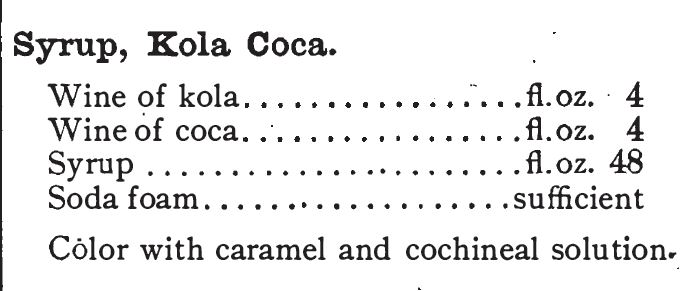
Syrup recipe for “Kola Coca” from The Standard Formulary: A Collection of Nearly Five Thousand Recipes, published 1900.
.
If imitation is the sincerest form of flattery, then “Kola Coca” syrup was known, at the turn of the century, to contain cocaine. Note the inclusion of Wine of Coca. Also notable, the Victorian use of “food coloring,” in the form of caramel and cochineal.
.
ATTACKS CONTINUED INTO THE NEXT DECADE
.
I’ve shared only a fraction of the testimonials by numerous, highly qualified chemists and scientist of the day. So many more were published in newspapers (the primary mode of communication to the public in the Victorian and Edwardian Era). No amount of reassurance made the problem go away. Just four years later (1911), Judge Sanford (Federal Court) ruled “that the coca-cola people must disclose the mysterious “merchandise No. 5,” the principal ingredient used in the manufacture of coca-cola syrup” [sic].
.

Coca-Cola won’t reveal Merchandise No 5. Part 1. Daily Press of Newport News, Virginia on march 25, 1911.

Coca-Cola won’t reveal Merchandise No 5. Part 2. Daily Press of Newport News, Virginia on march 25, 1911.
.

.
A BIG SECRET
.
Simon Whistler, in a relatively long (but fiercely entertaining) YouTube video about Coca-Cola’s recipe–speaks of the myth/”tall tale” that only two people at any given time know the trademark recipe. In the Bonus Facts near the conclusion, Simon explains that the “spent” coca leaves were used after 1903, thus providing flavor without the cocaine content. Not surprisingly, Simon’s information agrees with that of author Ricardo Cortés.
.
One thing is for certain: The More Things Change, The More They Remain The Same. Dr. L. Schaefer didn’t want to reveal the trade secrets he’d been entrusted with, hence the court order to spill the beans (after all, as Simon Whistler puts it, Secrets are Special). Likewise, Coca-Cola goes to great lengths to keep their formula a special secret… though not as secretive as only two people knowing all at the same time. This video is worth the 13.33 minutes (13 minutes, 20 seconds, AND commercial interruption). Enjoy!
.
.

.
Related Articles
.
![]()
.
Updated May 2022
Copyright © 2017 Kristin Holt LC
Cocaine in Victorian Coca-Cola: Going… Going… Gone?






